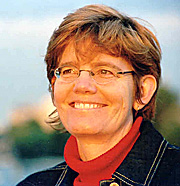
Poet, author, professor, and former Microsoft Internet guru Emily Warn has come home to Seattle. She brings with her a new book, Shadow Architect (Copper Canyon Press, July 2008), a poetic and visual foray into the legendary spiritual and regenerative power hidden within each letter of the 22-letter Hebrew alphabet.
Shadow Architect, a new collaboration with Northwest visual artist Dennis Evans, is a bit of a reversal for the Detroit-born poet. She has gone from computer code to mystical code — from Internet Explorer to Jewish internal exploration.
According to Warn, who spoke with JTNews from her home in Seattle, when one has the knowledge of the deep metaphysical meaning long associated with each of the Hebrew letters, the creative power of life itself may be revealed.
“I think our experience of the Divine takes place in language,” said Warn. “Bezalel, the master artist and craftsman in the Torah, knew how to do this. If you learned how to manipulate them, you had the power to create your own life narrative. We manipulated the letters to look at the generative power of art.”
Evans’ visual symbols of each Hebrew letter, along with Warn’s poetry, make up the 22 “kits” in the book. The idea, said Warn, is to give people a system of tools to create their own stories or life paths, just like Bezalel.
The fusion of poetry and imagery around each Hebrew letter describe a metaphysical process of spiritual self-realization, according to Warn, and can reveal the regenerative and creative power of language through art.
“Every poem in the book has four parts,” said Warn. “The first three relate to the Ba’al Shem Tov’s notion of the attributes and qualities of each letter in the Aleph-Bet. Every letter has a shape, a name and a number. The form relates to the world, the name to the soul, and the number to divinity.”
In the fourth section, Warn incorporates self-edited writings about the Hebrew letters from Rabbi Akiva, as well as quotations from the Torah and the Talmud.
Warn has written several other works, including two books of poetry, The Novice Insomniac (1996), and The Leaf Path, both published by Copper Canyon Press, and two shorter collections of poetry, The Highway Suit (1988), and The Book of Esther (1987).
Warn’s poetry is both edgy and wistful. It shadows her own ambivalence toward her religious background, having grown up the daughter of an Orthodox, fourth-generation Eastern European family from the province of Galicia, Poland.
Born in 1953, a time in American Jewish Orthodoxy when women had little opportunity to participate in public religious life, Warn drifted from her religious roots, but eventually found her way back to Judaism; a process that culminated while writing The Book of Esther.
According to Warn, that collection marks her re-entry into the religion of her youth. As she examines the story of the closeted Jewish queen who saved her people from mass murder, Warn brings the power of her own voice and the intellectual depth of Talmudic reasoning to the celebrated Jewish story.
“It’s my Midrash on the Book of Esther, and my re-visioning of who Esther was,” said Warn. “She kept her religion secret, and her power came from revealing her secret at just the right moment. How she revealed it is inseparable from her being a woman — that she could sway both the king and Haman.”
Warn is currently the outgoing Web editor for the Chicago-based The Poetry Foundation. She is also looking forward to writing another book inspired by the study of Talmud and Torah.
For now, Warn is catching her breath and enjoying being home in the Northwest.
“I want to respect the holy but speak as a woman and not be bridled,” added Warn. “My poems are art, they’re not religion. But they’re Jewish art. It’s Jewish poetry.”
